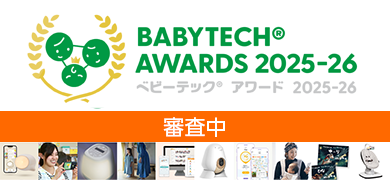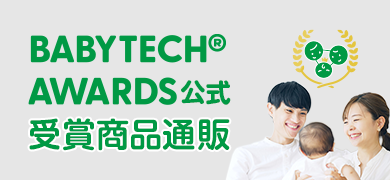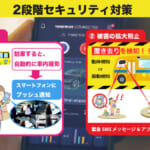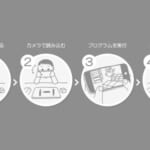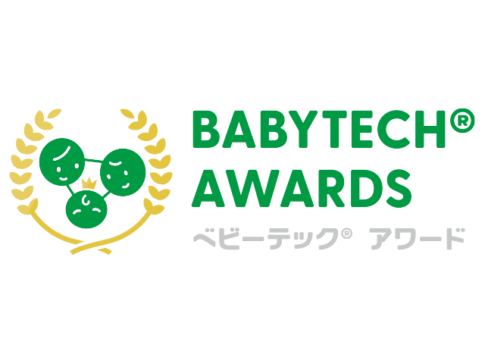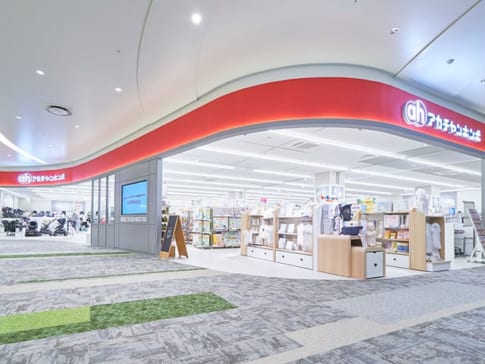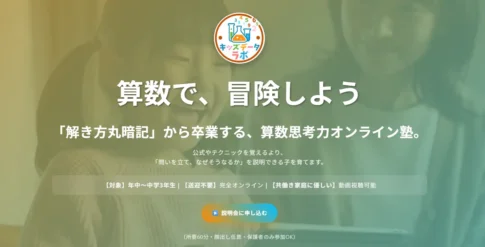- The following is content from the press release -
(Head office: Minato-ku, Tokyo; President: Shintaro Hashimoto; hereinafter "KIDS PLUS"), a developer and operator of business systems for preschools, and GAUSS Co. (headquartered in Shinjuku-ku, Tokyo; Tsunenori Utsunomiya, President; hereinafter "GAUSS"), which provides the edge AI camera x IoT platform GAUDiEYE, have started a joint experiment at Shonan Preschool (Chigasaki City, Kanagawa Prefecture) in order to supplement human error with the latest technology and prevent a recurrence, following a recent tragic incident in the news where a child was left on a bus to and from school and died from heat stroke. The two companies began a demonstration experiment at Shonan Preschool (Chigasaki City, Kanagawa Prefecture).
We aim to solve social issues by installing this system in all buses transporting children to and from kindergartens, which are located in approximately 10,000 facilities nationwide, so that tragic incidents such as the above will never occur again.

■Text
Background of introduction
Tragic incidents of preschool children dying of heat stroke due to being left unattended on pick-up buses have occurred repeatedly every year, and the government and local governments have provided guidance by making operation manuals mandatory, but no drastic solution has been reached because human attention is limited and human error occurs. Furthermore, having preschoolers press buttons and relying on them to do so does not constitute a safety measure.
Therefore, KIDS PLUS, with its strength in business systems for nursery schools and kindergartens, and GAUSS, with its strength in AI cameras, believe that it is necessary to prevent human error by utilizing the latest technology, and are aiming to prevent children from being left behind by installing the AI camera "GAUDiEYE" on pick-up buses. We will be happy to provide explanations and quotations to kindergarten operators and administrators who are considering anti-leaving systems, so please feel free to contact us for more information. Please feel free to contact us at sales@ml.gauss-ai.jp
Introduction Step
Step 1. Installation: (1) AI camera, (2) mobile Wi-Fi, and (3) mobile battery are installed in the car.
The camera is lightweight (approx. 150 g) and can be fixed with magnets or strong double-sided tape.
Step2. Detection: Adjust the detection sensitivity and set the detection area (coordinates of the target to be detected in the camera image).
AI detection can narrow down the video extracted by motion detection to only people and adjust sensitivity.
Step3. Notification: Set the e-mail address to be notified and the notification time (about 2~3 hours after the end of the operation).
Options include automatic voice notification to the representative phone and warning lights in the staff room.
GAUDiEYE Features.
(1) The AI camera can automatically detect and notify the administrator if a child has been left behind.
The AI camera combines motion and person detection and can notify the user of images (video) inside the bus only when a child is left behind.
What is GAUDiEYE?
GAUDiEYE, officially launched in April 2022, has attracted wide support for its product, which offers an AI camera at a low price while having a highly accurate AI and maintainable IoT management system (GAUDiHUB) that can easily be equipped with its own AI, reaching 500 units shipped, including forecasts by the end of the year The number of shipments has reached 500 units, including the forecast for the end of this year. This camera with AI functionality contributes to the safety and security of workplaces in manufacturing, construction, nursing care, and other fields, and prevents industrial accidents in case they occur and keeps a record of their occurrence.

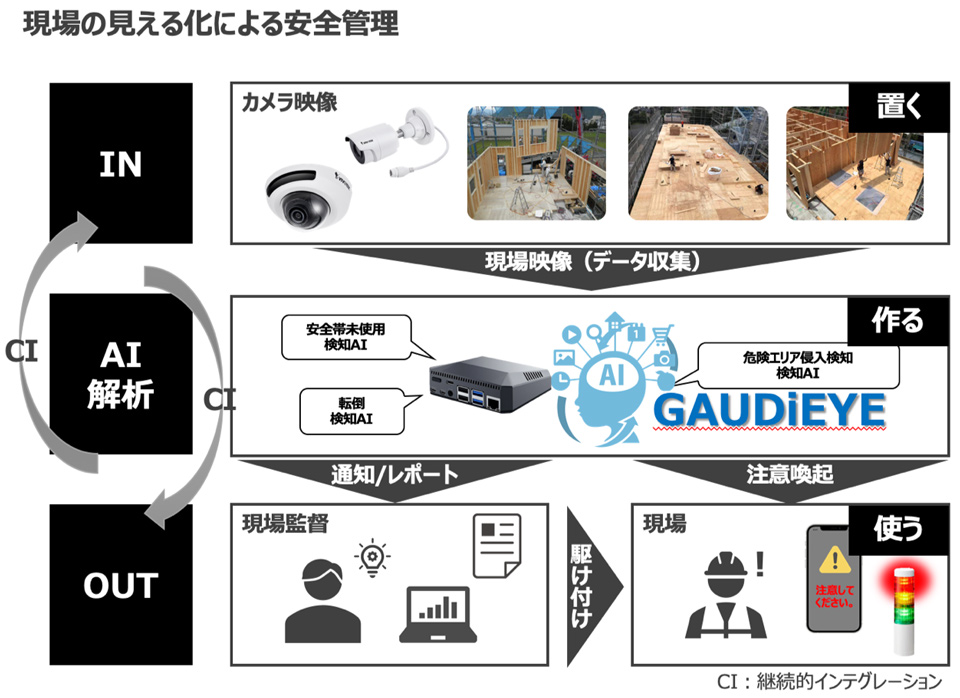
GAUDiEYE Features
(1) Object detection and alert notification by image recognition (e-mail, push notification, patrol lights, etc.)
→In addition to single conditions such as the presence or absence of human intrusion, notification conditions can be set for the status of multiple cameras (e.g., presence or absence of human intrusion while equipment is in operation).

(2) Area designation optimized for the site
→The customer can acquire camera images from the management screen, learn the most appropriate AI for the site, and set the danger areas by themselves.

(iii) Saving and retrieving video data, and optimizing AI models using on-site video as teacher data
→The customer can select the storage location (local/cloud) and storage period, and can create an AI model optimized for the installed site by retrieving video data from the management screen after the AI camera is installed, and using the on-site video as teacher data, the customer can create their own teacher data (annotations) and AI training.
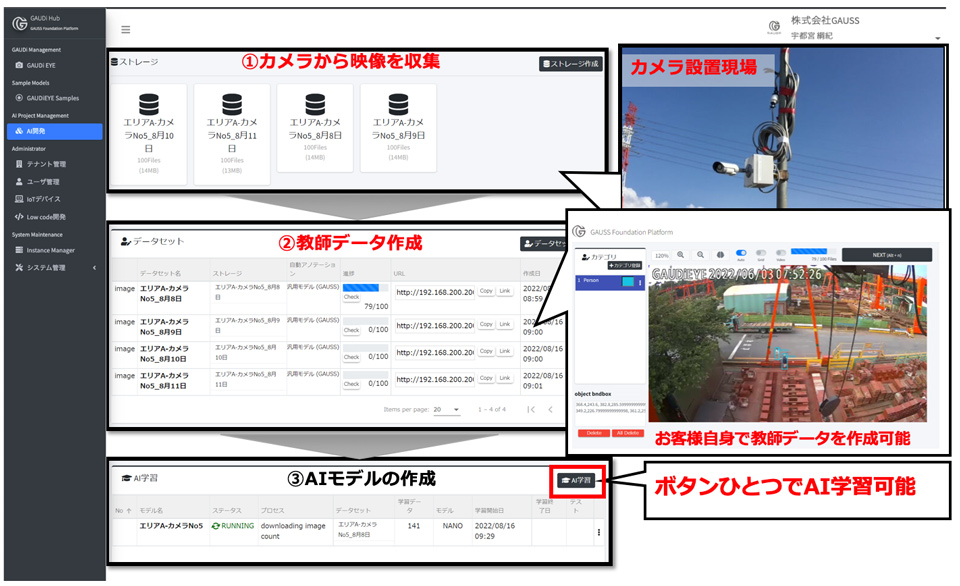
(4) AI model/IoT devices can be managed and multiple sites can be monitored even remotely
→The AI model and device management, which becomes complicated when AI cameras are installed in multiple areas, can be centrally managed remotely on the management screen, and images from multiple cameras can be displayed in a list view and camera data can be acquired remotely.

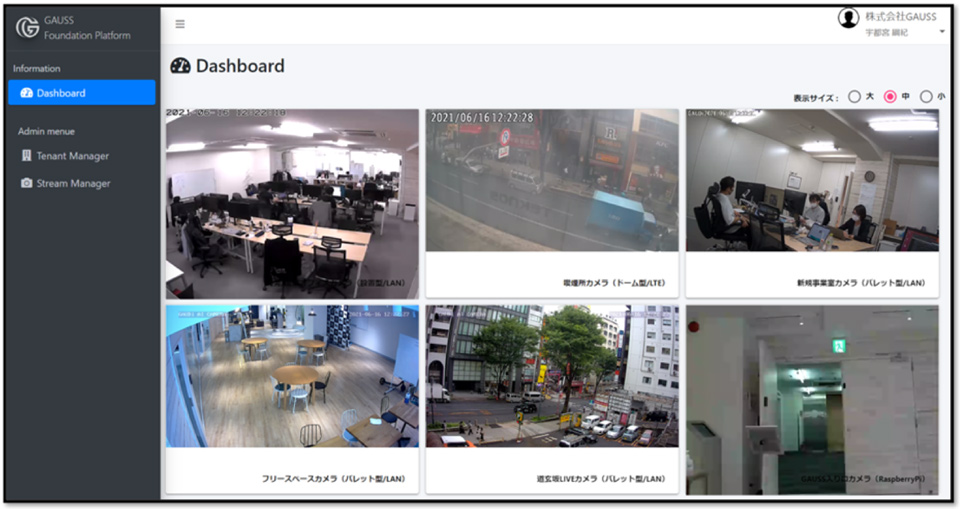
(5) Capable of linking with your services and systems and developing low-code
→By selecting a notification method from the management screen or developing image recognition AI detection and unique conditions in low code, you can add value to your products, launch new services, and control production facilities.
.
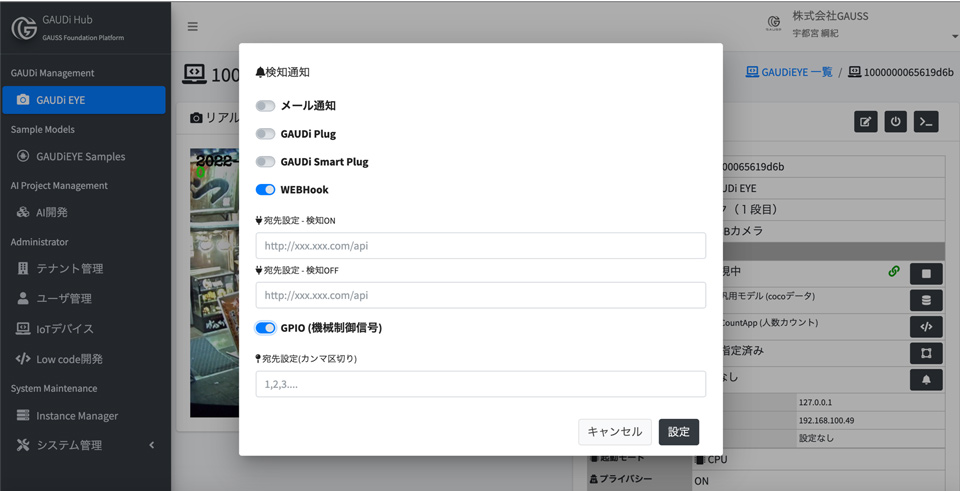
*Currently, this function is only available to GAUSS employees, but will be released in the future.

[Issues that can be resolved
No entry to dangerous areas / Detection of the use of safety equipment (safety belts, helmets, safety glasses, etc.) / Detection of entry to the crane's turning range / Congestion detection / Traffic count / Detection of wobbling and falling, etc.
→Contribute to safety and security at various sites
<Example of congestion detection (counting the number of people) and online mode

<Example of introduction of intrusion detection and offline mode in hazardous area


